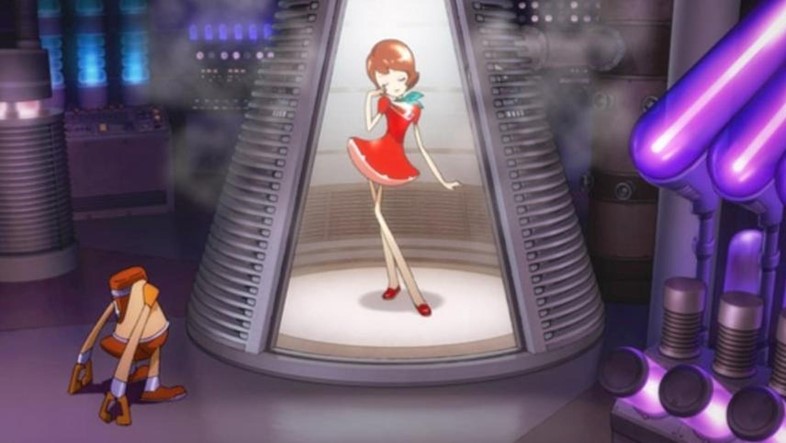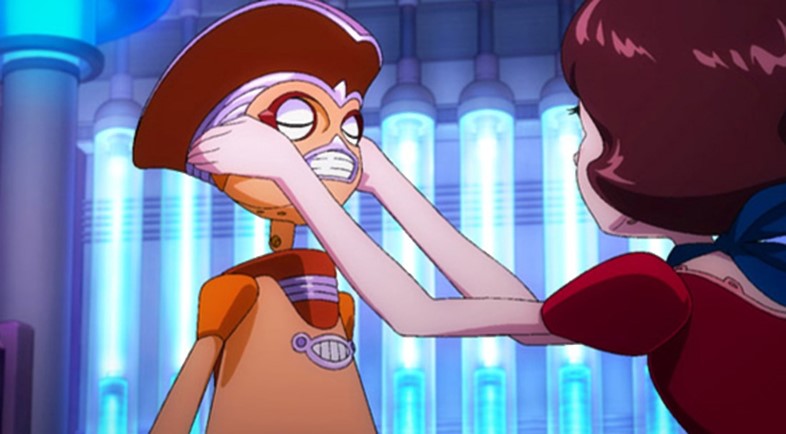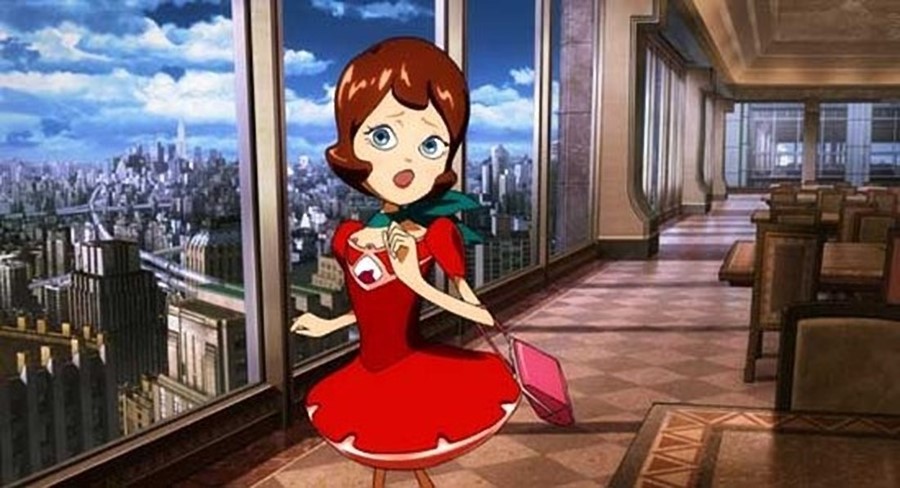We speak to the man tasked with completing the late filmmaker’s Dreaming Machine, but was the magical movie just never meant to be?
Satoshi Kon was one of the great cinematic conjurers. In the 90s and 00s, the cult anime director produced a slim body of work collapsing the boundaries between dreams and reality, space and time, and, ultimately, the nature of consciousness itself. But with his final project before his death from cancer at the age of 46, one last leap into the unknown may have proved beyond even him.
“I feel like he was born ten or 20 years too early and left 20 years before he should have,” producer Masao Maruyama tells Dazed of his friend and collaborator, a master storyteller whose quicksand narratives opened up new possibilities for cinema. Kon’s 1997 debut, Perfect Blue, was a cracked window on to Japan’s pop-cultural psyche by way of filmmakers Hitchcock and De Palma. Millennium Actress (2001) was an elegiac meditation on a life lived through cinema. Tokyo Godfathers (2003) was Kon’s Straight Story, a comedy-drama touching on issues of family and homelessness. And Paprika (2006), his most ambitious work, was a wild sci-fi parable on the internet’s potential to unleash dark forces of the collective unconscious on humanity.
Surprisingly, Kon’s last feature, Dreaming Machine, was to be a children’s film about the adventures of three robots. “I said, ‘I don’t mind what the story is, but let’s have a red robot, a blue robot and a yellow robot,’” recalls Maruyama of his premise for the film – almost comically slender, given Kon’s track-record in mind-melting stories to date. The producer and former Madhouse studio boss suggested his idea after the release of Tokyo Godfathers, though Kon would end up making Paprika before moving forward with the project.

Sadly, it was not to be. In 2010, shortly after he began work on Dreaming Machine, Kon was diagnosed with terminal pancreatic cancer and given six months to live. Fearing his film would never make it to the screen, he sought reassurances from Maruyama that the producer would oversee its completion in the event of his death.
Kon passed away in August 2010, just three months after his diagnosis. In a letter written shortly before his death, the director reiterated his fears for the film, which he called his “biggest regret”: “I haven’t been idly waiting for death, even now I’m thinking with my weak brain of ways to let the work live even after I am gone. But they are all shallow ideas. When I told Maruyama-san about my concerns about Dreaming Machine, he just said, ‘Don’t worry. We’ll figure out something, so don’t worry.’
“I wept. I wept uncontrollably.”
Maruyama’s ties with the director go back as far as Perfect Blue, when Kon was an acclaimed manga artist and jobbing scriptwriter. He says he “knew right away” that Kon was a rare talent: “He’d been drawing manga previously and there were elements of (his vision) scattered throughout those. Gradually, he concentrated these elements into his work as an animation director. But it’s something I noticed straight away.”
Kon’s films were acclaimed in their time, drawing raves on the festival circuit and even, in the case of Perfect Blue, finding a Hollywood suitor in director Darren Aronofsky, who considered filming a live-action remake. But they performed only modestly at the box office, with only his last film, Paprika, suggesting word of his brilliance was starting to get out (it made less than $1m worldwide). In recent years, that cult has grown considerably, with Kon’s influence on the likes of Aronofsky and Christopher Nolan now something of an internet meme, and his otherworldly DNA showing up in films like Makoto Shinkai’s Your Name, which became the highest-grossing anime of all time in 2016.

“Finally, I think people are beginning to understand (Kon’s work),” says Maruyama. “I feel like he was ahead of his time in terms of what he was trying to do and in terms of his talent. Back then, animation wasn’t really seen as entertainment and art. Now it’s different: there are all types of animation, styles, modes of expression. But Satoshi was on top of that before anyone else and better than anyone else.”
The first difficulty Maruyama faced in making Dreaming Machine a reality was money: in 2011, the producer revealed that the project had been put on hold for financial reasons, with 600 of the film’s 1,500 shots animated. The following year, he stated his goal to raise enough money to complete the film by 2017 – but that wasn’t the only problem he was up against. He also needed the right person for the job.
Directors have had their unfinished projects completed posthumously before, but the end result tends to raise the question of whose vision we end up seeing on screen. AI, a film developed by Stanley Kubrick for many years before passing it on to Steven Spielberg, was a curious mash-up of the two directors’ styles released two years after Kubrick’s death. It’s the same circle Maruyama kept trying to square, with no success. He approached a number of directors about completing the film, many at Kon’s own suggestion. The problem, he explains, is that “they were all strong directors in their own right, with their own unique style”.
“(Kon) had already done storyboards, he’d already made part of the film,” says Maruyama. “I’ve thought about this for five years, but what I finally realised we can’t do is let someone else take over where Kon-san left off and let someone else take up the reins. If someone else were to direct, it just wouldn’t be his film any more.”
“Back then, animation wasn’t really seen as entertainment and art. Now it’s different: there are all types of animation, styles, modes of expression. But Satoshi was on top of that before anyone else and better than anyone else” – Masao Maruyama
So what do we actually know about the film that Kon was making? Details are disappointingly thin on the ground: a few promotional stills were teased online in 2009, some of which you can see in the gallery above. The plot, as Maruyama suggests, revolves around three robot characters – Ririco, described as a “small, leaderly, Paprika-like character”, Robin (small, yellow) and King (big, loyal, blue) – and their battle with an “electric monster baddie” (according to Maruyama). However, this being a Kon movie, larger questions would surely have been at stake.
“On the surface, it’s going to be a fantasy-adventure targeted at younger audiences,” Kon told Anime News Network in 2008. “However, it will also be a film that people who have seen our films up to this point will be able to enjoy. So it will be an adventure that even older audiences can appreciate. There will be no human characters in the film, only robots. It’ll be like a ‘road movie’ for robots.” Maruyama echoes the sentiment today, explaining that Kon “wasn’t interested in making something ‘easy’ for children, in the same way he wasn’t making something harder for grown-ups (with his other films)... That’s just a way of getting as many people as possible watching the film.”
One other revealing snippet about Dreaming Machine: its title comes from a song by Susumu Hirasawa, of influential techno-pop pioneers P-Model. “Kon-san had been a big fan of my music for a long time,” says Hirasawa, who was approached about working on the film after contributing a song, “Rotation”, to the Millennium Actress soundtrack. “You can see that from some of the scenes in his films, such as my CD being on a desk or my song’s title in an advertisement on the train.”

Hirasawa rerecorded “Dreaming Machine” – a track from his 1990 album The Ghost in Science – for the new film’s soundtrack, while another old song of his, “Sailing Ship 108”, was used by Kon to edit a scene with no dialogue in which the robots are dancing. Kon revealed little about the film to the musician, who also wrote original music for its theme. “He didn’t express anything about his idea of the deep meaning behind the film to me,” says Hirasawa. “I think he trusted me and thought that, once I heard his idea, I would soon reach the ‘source’.”
As to what that ‘source’ may be, Maruyama thinks Kon may have had a message about nuclear power somewhere in mind with the film. Hirasawa, meanwhile, remains cryptic about what the “deeper messages hidden within the story” might be. “What the dreaming machine refers to, most people might think, is the performing robots in the story,” he says. “That would not be wrong, but I think about it differently... We have, however, no chance to find if any answer is right or not.” Kon seems to have shared Hirasawa’s feeling that the secrets of Dreaming Machine would be taken to his grave, writing with regret in his farewell letter that “basically most of the work can only be understood by (me)”.
But, whatever Kon’s intentions for the movie, now the Dreaming Machine has become something else. It’s the story of one man’s dying wish, and his friend’s attempts to fulfil it. It’s a story about how we celebrate the work of artists after they’re gone, and the special burden on those tasked with keeping the flame alive. “If he were to come back from beyond the grave, I would do it in a flash,” says Maruyama, conceding that the film now remains “frozen in time”. But Kon’s dreams live on.




